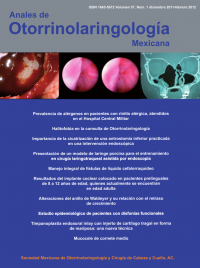
Resumen
Antecedentes
Los estudios realizados a pacientes implantados tardíamente demuestran una diferencia significativa a favor de los niños pequeños, pero no dejan claro si es realmente justificable implantarlos o no. Por eso, es importante poder determinar si el beneficio del implante en esta población sobrepasa los riesgos y costos en comparación con la alternativa de no implantar.
Objetivo
Determinar, en comparación con la alternativa de no implantar, si se beneficia significativamente la calidad de vida, las habilidades auditivas, el lenguaje expresivo y la socialización de los pacientes prelinguales de 8 a 12 años de edad cuando se les coloca un implante coclear.
Metodología
El estudió constó de dos grupos: uno de 23 participantes prelinguales de 18 años de edad en adelante que fueron implantados cuando tenían entre 8 y 12 años y otro de 17 pacientes con las mismas características pero sin el dispositivo. Se evaluaron las habilidades de socialización y lenguaje expresivo por medio de preguntas diseñadas y aplicadas con anterioridad. Además, parte de la Escala de Integración Auditiva Significativa (MAIS por sus siglas en inglés) y el Índice de Bienestar Personal-Adultos (PWI-A por sus siglas en inglés) se utilizaron para valorar las habilidades auditivas y la calidad de vida, respectivamente. Se aplicó la prueba de rangos de Wilcoxon para determinar si ambos grupos diferían significativamente; sí se encontraron diferencias significativas en habilidades auditivas, lenguaje expresivo y calidad de vida.
Resultados
Respecto a los métodos de rehabilitación previos al implante coclear, la mayoría acudió a terapia auditiva verbal (48%) y a oral (39%), con lectura labiofacial; 4% estuvo en el método total y 9% en el manual. Después del implante, 83% se rehabilitó con el método auditivo verbal (MAV), y 17%, con el oral, lo cual coincidió con el hecho de que el MAV es el que más promovió que el paciente integrara la audición a su personalidad para desarrollar habilidades sociales y de
Abstract
Background
Studies in patients who got a late implant show a significant difference favorable to young children, but they do not make it clear enough whether implantation is really justified or not. Therefore it is important to establish whether the benefit of the implant in this population segment outweighs the risks and costs compared with the alternative of not implanting.
Objective
To determine, in comparison with patients that did no receive implants, whether cochlear implants significantly benefit quality of life, listening skills, expressive language and socialization of prelingual patients between 8 and 12 years old.
Methodology
The study consisted of two groups: one of 23 prelingual participants of 18 years of age and older who received implants when they were 8 and 12, and another of 17 similar patients but without the device. We assessed social skills and expressive language through questions designed and implemented earlier. In addition, part of the Meaningful Auditory Integration Scale (MAIS) and the Personal Wellbeing Index-Adult (PWI-A) were used to assess auditory skills and quality of life respectively. We applied the Wilcoxon rank test to determine whether both groups differed significantly and found significant differences in auditory skills, expressive language and quality of life.
Results
Regarding the methods of rehabilitation prior to cochlear implantation, most resorted to auditory verbal therapy (48%) and oral therapy (39%), with lip-reading; 4% underwent the whole method, and 9% tried the manual one. After implantation, 83% were rehabilitated with an auditory verbal approach (MAV), and 17% with the oral one, which coincided with the fact that the AVM promoted best that the patient integrated hearing to their personality in order to develop social and communication skills. In conclusion, there were significant differences in favor of the non-implanted, possibly indicating that there is greater cohesion
32

